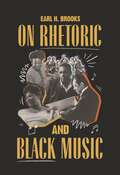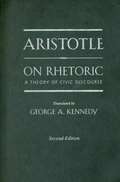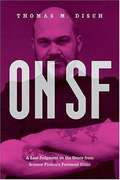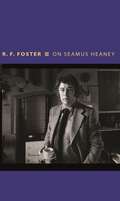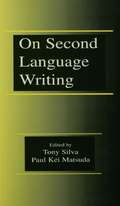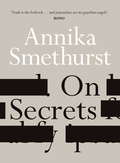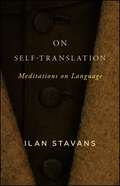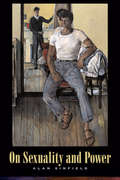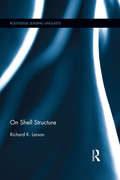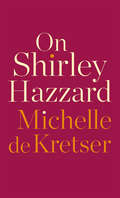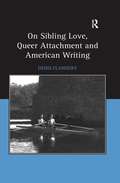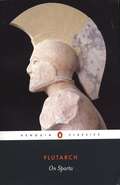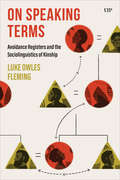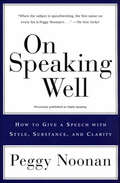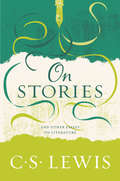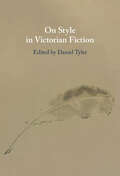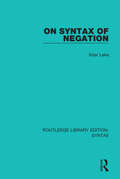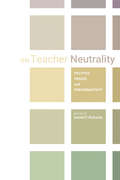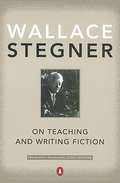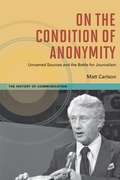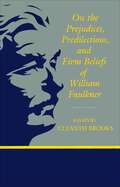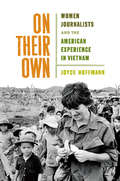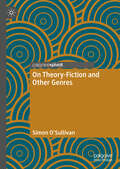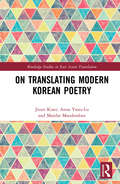- Table View
- List View
On Rhetoric and Black Music (African American Life Series)
by Earl H. BrooksThis groundbreaking analysis examines how Black music functions as rhetoric, considering its subject not merely reflective of but central to African American public discourse. Author, musician, and scholar Earl H. Brooks argues that there would have been no Harlem Renaissance, Civil Rights Movement, or Black Arts Movement as we know these phenomena without Black music. Through rhetorical studies, archival research, and musical analysis, Brooks establishes the "sonic lexicon of Black music," defined by a distinct constellation of sonic and auditory features that bridge cultural, linguistic, and political spheres with music. Genres of Black music such as blues and jazz are discursive fields, where swinging, improvisation, call-and-response, blue notes, and other musical idioms serve as rhetorical tools to articulate the feelings, emotions, and states of mind that have shaped African American cultural and political development. Examining the resounding artistry of iconic musicians such as Scott Joplin, Mary Lou Williams, Duke Ellington, John Coltrane, and Mahalia Jackson, this work offers an alternative register in which these musicians and composers are heard as public intellectuals, consciously invested in crafting rhetorical projects they knew would influence the public sphere.
On Rhetoric: A Theory of Civic Discourse
by Aristotle George A. KennedyThis new edition of George A. Kennedy's highly acclaimed translation and commentary offers the most faithful English version ever published of Aristotle's classic work, On Rhetoric.
On SF
by Thomas M. DischThis collection by the much-loved and lauded science-fiction writer Thomas Disch spans twenty-five years of his career, during which he has supplemented his creative output with reviews and critical essays in publications as diverse as the Nation, the New York Times Book Review, the Atlantic Monthly, and Twilight Zone. Disch's perspectives on his genre are skeptical, novel, and often incendiary. The volume's opening essay, for example, characterizes writers of science fiction as "the provincials of literature." Other essays explore science fiction's roots-Poe, Bradbury, Clarke, Asimov, Vonnegut-as well as modern practitioners such as Stephen King, Philip Dick, Robert Heinlein, L. Ron Hubbard, and William Gibson. Disch entertains and provokes with essays on UFOs, Science Fiction as a Church, and Newt Gingrich's Futurist Brain Trust. Close Encounters of the Third Kind and Madame Blavatsky also get the Disch treatment. Throughout, the writing is lively, agile, and irreverent, exhibiting an incisive honesty that is undiluted by Disch's own attachments as a sci-fi practitioner. On SF will appeal equally to lovers of science fiction and connoisseurs of the finest critical prose.
On Seamus Heaney (Writers on Writers #13)
by Roy FosterA vivid and original account of one of Ireland’s greatest poets by an acclaimed Irish historian and literary biographerThe most important Irish poet of the postwar era, Seamus Heaney rose to prominence as his native Northern Ireland descended into sectarian violence. A national figure at a time when nationality was deeply contested, Heaney also won international acclaim, culminating in the Nobel Prize for Literature in 1995. In On Seamus Heaney, leading Irish historian and literary critic R. F. Foster gives an incisive and eloquent account of the poet and his work against the background of a changing Ireland.Drawing on unpublished drafts and correspondence, Foster provides illuminating and personal interpretations of Heaney’s work. Though a deeply charismatic figure, Heaney refused to don the mantle of public spokesperson, and Foster identifies a deliberate evasiveness and creative ambiguity in his poetry. In this, and in Heaney’s evocation of a disappearing rural Ireland haunted by political violence, Foster finds parallels with the other towering figure of Irish poetry, W. B. Yeats. Foster also discusses Heaney’s cosmopolitanism, his support for dissident poets abroad, and his increasing focus in his later work on death and spiritual transcendence. Above all, Foster examines how Heaney created an extraordinary connection with an exceptionally wide readership, giving him an authority and power unique among contemporary writers.Combining a vivid account of Heaney’s life and a compelling reading of his entire oeuvre, On Seamus Heaney extends our understanding of the man as it enriches our appreciation of his poetry.
On Second Language Writing: Perspectives On The Process Of Knowledge Construction
by Paul Kei Matsuda Tony SilvaOn Second Language Writing brings together internationally recognized scholars in a collection of original articles that, collectively, delineate and explore central issues with regard to theory, research, instruction, assessment, politics, articulation with other disciplines, and standards. In recent years, there has been a dramatic growth of interest in second-language writing and writing instruction in many parts of the world. Although an increasing number of researchers and teachers in both second-language studies and composition studies have come to identify themselves as specialists in second-language writing, research and teaching practices have been dispersed into several different disciplinary and institutional contexts because of the interdisciplinary nature of the field. This volume is the first to bring together prominent second-language writing specialists to systematically address basic issues in the field and to consider the state of the art at the end of the century (and the millennium).
On Secrets
by Annika SmethurstOn June 4, Federal Police raided the home of Walkley award-winning journalist Annika Smethurst, changing her life forever.Police claim they were investigating the publication of classified information, her employer called it a 'dangerous act of intimidation', Smethurst believes she was simply doing her job.Smethurst became the accidental poster woman for press freedom as politicians debated the merits of police searching through her underwear drawer. In On Secrets she will discuss the impact this invasion has had on her life, and examine the importance of press freedom.
On Self-Translation: Meditations on Language (SUNY Press Open Access)
by Ilan StavansFinalist for the 2018 Foreword INDIES Book of the Year Awards in the Essay categoryFrom award-winning, internationally known scholar and translator Ilan Stavans comes On Self-Translation, a collection of essays and conversations on language in its multifaceted forms. Stavans discusses the way syntax is being restructured by texting and other technologies. He examines how the alphabet itself is being forgotten by the young, how finger snapping has taken on a new meaning, how the use of ellipses has lapsed, and how autocorrect is shaping the way we communicate. In an incisive meditation, he shows how translating one's own work reinvents oneself in another tongue. The volume includes tête-à-têtes with Pulitzer Prize–winner Richard Wilbur and short-fiction master Lydia Davis, as well as dialogues on silence, multilingualism, poetry, and the durability of the classics. Stavans's explorations cover Spanish, English, Hebrew, Yiddish, and the hybrid lexicon of Spanglish. He muses on the meaning of foreignness and on living and dying in different languages. Among his primary concerns are the role and history of dictionaries and the extent to which the authority of language academies is less a reality than a delusion. He concludes with renditions into Spanglish of portions of Hamlet, Don Quixote, and The Little Prince. The wide range of themes and engaging yet informed style confirm Stavans's status, in the words of the Washington Post, as "Latin America's liveliest and boldest critic and most innovative cultural enthusiast."This book is freely available in an open access edition thanks to Knowledge Unlatched—an initiative that provides libraries and institutions with a centralized platform to support OA collections and from leading publishing houses and OA initiatives. Learn more at the Knowledge Unlatched website at: https://www.knowledgeunlatched.org/, and access the book online at the SUNY Open Access Repository at <a href="http://hdl.handle.net/20.500.12648/7137 ">http://hdl.handle.net/20.500.12648/7137 .
On Sexuality and Power (Between Men-Between Women: Lesbian and Gay Studies)
by Alan SinfieldIt is widely supposed that the most suitable partner will be someone very much like oneself; gay fiction and cinema are often organized around this assumption. Nonetheless, power differentials are remarkably persistent—as well as sexy. What are the personal and political implications of this insight?Sinfield argues that hierarchies in interpersonal relations are continuous with the main power differentials of our social and political life (gender, class, age, and race); therefore it is not surprising that they govern our psychic lives. Recent writing enables an exploration of their positive potential, especially in fantasy, as well as their danger.On Sexuality and Power focuses on the writing of the last thirty years, revisiting also Whitman, Wilde, Mann, Forster, and Genet, and reassessing the very idea of a gay canon.
On Shell Structure: On Shell Structure (Routledge Leading Linguists)
by Richard K. LarsonThis volume collects together core papers by Richard K. Larson developing what has since come to be known as the "VP Shell" or "Split VP" analysis of sentential structure. The volume includes five previously published papers together with two major unpublished works from the same period: "Light Predicate Raising" (1989), which explores the interesting consequences of a leftward raising analysis of "NP Shift" phenomena, and "The Projection of DP (and DegP)" (1991), which extends the shell approach to the projection of nominal and adjectival structure, showing how projection can be handled in a uniform way. In addition to published, unpublished and limited distribution work, the volume includes extensive new introductory material. The general introduction traces the conceptual roots of VP Shells and its problems in the face of subsequent developments in theory, and offers an updated form compatible with modern Minimalist syntactic analysis. The section introductions to the material on datives, complex predicates and nominals show how the updated form of shell theory applies in the empirical domains where it was originally developed.
On Shirley Hazzard: Writers On Writers (Writers On Writers Ser.)
by Michelle De KretserOn Shirley Hazzard is a vibrant and personal tribute in which the Miles Franklin Award–winning novelist Michelle de Kretser offers a masterclass in writing and reading. She celebrates the precision and musicality of Hazzard’s prose and illuminates the humor and humanity in her work. This exhilarating book is both a brilliant introduction to Hazzard and a gift for her longtime readers.On Shirley Hazzard reveals Michelle de Kretser’s lively intelligence at work and her distinctive wit. This testament to her sustained engagement with Hazzard’s work is, at its core, an appreciation of the significance and joy of good fiction. Receptiveness when reading is a prerequisite for perceptive analysis, according to both de Kretser and Hazzard. And for prose, the “simple and precise,” the “transient and insignificant” are key qualities: “Not moonlight but the glitter of broken glass,” for de Kretser as for Chekhov. Selective biographical details about Hazzard are relayed, too—her leaving Australia and formal education at the age of sixteen, her working, unhappily, at the United Nations in Manhattan, her long friendship with Graham Greene. Hazzard’s morality is also invoked—“solidarity with the vulnerable” and pacifism being of prime importance.Shirley Hazzard (1931–2016) published her first short story in The New Yorker in 1961. The magazine continued to publish her work in the decades thereafter, including excerpts from her most successful and beloved novel, the bestseller and National Book Critics Circle Award winner, The Transit of Venus (1980). Michelle de Kretser’s insightful and provocative appreciation does Hazzard fine justice.
On Sibling Love, Queer Attachment and American Writing
by Denis FlannerySibling bonds, both literal and figurative, have had a crucial role in American writings of queer desire and identity. In nuanced and original readings, Denis Flannery demonstrates the centrality of fraternal and sororal love to queer strands of nineteenth- and twentieth-century texts from the elemental wildnesses of Moby-Dick to David Fincher's postmodern cinema; from the brutal and comic decorum of Henry James's major fiction to the elegiac memoir-writing of Jamaica Kincaid. Questions driving Flannery's exploration of sibling relations: How do we characterize the relationship between sibling love, queer possibility and the formal intensities of American writing? Why do so many American texts rely on the presence of sibling love to articulate queer desire? Why is brotherhood invoked as a positive value in announcements of United States national aspirations but used repeatedly and ominously in that nation's texts to herald a fall? Written with lyrical clarity and verve, On Sibling Love, Queer Attachment and American Writing is an important contribution to queer theory; to American studies; and to the study of culture, writing and affect.
On Sparta (Revised Edition)
by Plutarch Richard J. A. TalbertPlutarch's vivid and engaging portraits of the Spartans and their customs are a major source of our knowledge about the rise and fall of their remarkable Greek city-state between the sixth and third centuries BC. Through his Lives of Sparta's leaders and his recording of memorable Spartan Sayings, he depicts a people who lived frugally and mastered their emotions in all aspects of life, who disposed of unhealthy babies in a deep chasm, introduced a grueling regimen of military training for boys, and treated their serfs brutally. Rich in anecdote and detail, Plutarch's writing brings to life the personalities and achievements of Sparta with unparalleled flair and humanity. The revised edition includes a new introduction, a new essay on Plutarch, notes, a glossary, updated further reading, and an index Includes four maps and a list of the kings of Sparta to 222 BC.
On Speaking Terms: Avoidance Registers and the Sociolinguistics of Kinship (Studies in the Anthropology of Language, Sign, and Social Life)
by Luke FlemingWhy are kin, in societies all over the world, divided into “joking” and “avoidance” relations? Foundational figures in the human sciences, from E.B. Tylor and Alfred Radcliffe-Brown to Sigmund Freud and Claude Lévi-Strauss, have sought to explain why some classes of kin are normatively expected to prank and tease one another while others must studiously avoid each other’s presence. In this extensively researched comparative study, linguistic anthropologist Luke Owles Fleming offers a bold new answer to this problem. With a particular focus on avoidance relationships, On Speaking Terms argues that in order to understand cross-cultural convergences in the patterning of kinship-keyed comportments, we must attend to the sociolinguistic codes through which kinship relationships are enacted. Drawing on ethnographic data from more than one hundred different societies, the book documents and analyses parallels in the linguistic and non-verbal signs through which avoidance relationships are experientially realized. With dedicated discussions of Aboriginal Australian “mother-in-law languages,” name and word tabooing practices, pronominal honorification, and non-verbal strategies of interactional and sensorial avoidance, it reveals recurrent sociolinguistic patterns attested in kinship avoidance. In demonstrating the vital role of sociolinguistic codes for transforming kinship categories into phenomenologically rich relationships, On Speaking Terms makes an important contribution to the anthropology of kinship.
On Speaking Well: How to Give a Speech with Style, Substance, and Clarity
by Peggy NoonanA presidential speechwriter offers practical wisdom and insightful tips in this authoritative guide to writing and giving a speech.For anyone who fears the thought of writing and giving a speech—be it to business associates, or at a wedding—help is at hand. Acclaimed presidential speechwriter Peggy Noonan shares her secrets to becoming a confidence, persuasive speaker demystifying topics including:Finding you own authentic voiceDeveloping a text that interests youAcing the all-important first paragraphUsing logic to move your audienceCreating, developing, and reinventing the “core speech” for diverse audiencesStrengthening your speech with a vital element: humorWinnowing your thoughts down to the essentialsHandling professional jargon, clichés, and the sound bite syndromeRespecting simplicity and clarity—big ideas need small wordsPresenting your speech in the best wayCollecting intellectual income—conversing your speech treasuresBreaking all the rules and still succeedingReading for inspiration—how to use the excellence of othersComplete with lessons, tips and memorable examples, On Speaking Well shows us how to create forceful, persuasive, relevant speeches that will resonate with our audiences. Engaging, informative, and always entertaining, this is undoubtedly the authoritative how-to guide for anyone writing or giving a speech.
On Stories
by C. S. LewisThe theme of this collection is the excellence of the Story, especially the kind of story dear to Lewis-fantasy and science fiction, which he fostered in an age dominated by realistic fiction. On Stories is a companion volume to Lewis's collected shorter fiction, The Dark Tower and Other Stories. Edited and with a Preface by Walter Hooper.
On Stories: And Other Essays on Literature
by C. S. LewisA repackaged edition of the revered author’s collection of essays on writing fiction.C. S. Lewis—the great British writer, scholar, lay theologian, broadcaster, Christian apologist, and bestselling author of Mere Christianity, The Screwtape Letters, The Great Divorce, The Chronicles of Narnia, and many other beloved classics—was a professor of literature at Oxford University, where he was known for his insightful and often witty presentations on the nature of stories. This collection assembles nine essays that encapsulate his ideas about fiction, including "On Stories," "The Death of Words," and "On Three Ways of Writing for Children," as well as eleven pieces that were unpublished during his lifetime.
On Style in Victorian Fiction
by Daniel TylerSome writers of the Victorian period, as well as more recent critics, have argued that the prose style of Victorian fiction aims to efface itself or that an absence of style may in itself represent the nineteenth-century ideal. This collection provides a major assessment of style in Victorian fiction and demonstrates that style - the language, techniques and artistry of prose - is inseparable from meaning and that it is through the many resources of style that the full compass of meaning makes itself known. Leading scholars in the field present an engaging assessment of major Victorian novelists, illustrating how productive and illuminating close attention to literary style can be. Collectively, they build a fresh and nuanced understanding of how style functioned in the literature of the nineteenth century, and propose that the fiction of this era demands we think about what style does, as much as what style is.
On Syntax of Negation (Routledge Library Editions: Syntax #14)
by Itziar LakaThe central concern of this title, first published in 1994, is the syntactic nature of negation in Universal Grammar, and its relation to other functional elements in the Syntax. The study argues that negation is not a syntactic category on its own; rather, it is one of the values of a more abstract syntactic category, named Σ, which includes other sentence operators, such as affirmation and emphasis. This title will be of interest to students of language and linguistics.
On Teacher Neutrality: Politics, Praxis, and Performativity
by Daniel P. RichardsOn Teacher Neutrality explores the consequences of ideological arguments about teacher neutrality in the context of higher education. It is the first edited collection to focus exclusively on this contentious concept, emphasizing the practical possibilities and impossibilities of neutrality in the teaching of writing, the deployment of neutrality as a political motif in the public discourse shaping policy in higher education, and the performativity of individual instructors in a variety of institutional contexts. The collection provides clarity on the contours around defining “neutrality,” depth in understanding how neutrality operates differently in various institutional settings, and nuance in the levels and degrees of neutrality—or what is meant by it—in the teaching of writing. Higher education itself and its stakeholders are continually exploring the role of teachers in the classroom and the extent to which it is possible or ethical to engage in neutrality. Amplifying voices from teachers in underrepresented positions and institutions in discussions of teacher ideology, On Teacher Neutrality shapes the discourse around these topics both within the writing classroom and throughout higher education. The book offers a rich array of practices, pedagogies, and theories that will help ground instructors and posits a way forward toward better dialogue and connections with the various stakeholders of higher education in the United States. Contributors: Tristan Abbott, Kelly Blewett, Meaghan Brewer, Christopher Michael Brown, Chad Chisholm, Jessica Clements, Jason C. Evans, Heather Fester, Romeo García, Yndalecio Isaac Hinojosa, Mara Holt, Erika Johnson, Tawny LeBouef Tullia, Lauren F. Lichty, Adam Pacton, Daniel P. Richards, Patricia Roberts-Miller, Karen Rosenberg, Allison L. Rowland, Robert Samuels, David P. Stubblefield, Jennifer Thomas, John Trimbur
On Teaching and Writing Fiction
by Wallace StegnerWallace Stegner founded the acclaimed Stanford Writing Program-a program whose alumni include such literary luminaries as Larry McMurtry, Robert Stone, and Raymond Carver. Here Lynn Stegner brings together eight of Stegner's previously uncollected essays-including four never-before-published pieces -on writing fiction and teaching creative writing. In this unique collection he addresses every aspect of fiction writing-from the writer's vision to his or her audience, from the use of symbolism to swear words, from the mystery of the creative process to the recognizable truth it seeks finally to reveal. His insights will benefit anyone interested in writing fiction or exploring ideas about fiction's role in the broader culture. .
On The Condition of Anonymity
by Matt CarlsonMatt Carlson confronts the promise and perils of unnamed sources in this exhaustive analysis of controversial episodes in American journalism during the George W. Bush administration, from prewar reporting mistakes at the New York Times and Washington Post to the Valerie Plame leak case and Dan Rather's lawsuit against CBS News. Weaving a narrative thread that stretches from the uncritical post-9/11 era to the spectacle of the Scooter Libby trial, Carlson examines a tense period in American history through the lens of journalism. Revealing new insights about high-profile cases involving confidential sources, he highlights contextual and structural features of the era, including pressure from the right, scrutiny from new media and citizen journalists, and the struggles of traditional media to survive amid increased competition and decreased resources.
On The Prejudices, Predilections, and Firm Beliefs of William Faulkner (Southern Literary Studies)
by Cleanth BrooksIt seems appropriate, if not inevitable, that one of our best critics should be the foremost authority on one of our best novelists. Cleanth Brooks, the author of three seminal studies of William Faulkner, has been a serious student of that master craftsman's fiction for more than four decades. In this new collection, Brooks considers many of the important characteristics of Faulkner's work. He focuses more specifically than he has in the past on certain questions and in some instances offers rebuttals to what he considered unfair assessments of Faulkner. In the first essay, Brooks challenges the notion that Donald Davidson, John Crowe Ransom, Robert Penn Warren, and other members of the Fugitive-Agrarian movement at Vanderbilt University were slow to recognize Faulkner's achievements. Indeed, Brooks provides clear evidence not only that the Fugitives were early supporters of Faulkner but that Faulkner and the Fugitives shared many concerns and ideas about their region. Brooks also writes about Faulkner's personal beliefs and demonstrates how the virtues Faulkner held in highest esteem -- such as courage and honor -- are embodied in his fiction. In two essays, "Faulkner and the Community" and "Faulkner's Two Cities," Brooks analyzes the importance of a closely knit world -- specifically the hill region of north Mississippi and the cities of Memphis and New Orleans -- to Faulkner's works.Brooks considers Faulkner's serious regard for the chivalric tradition, as well as his amusement in Gavin Stevens' exemplification of it in Intruder in the Dust and Requiem for a Nun. Faulkner's treatment of women characters, especially in Light in August and The Hamlet, is discussed, as are his ideas about the American Dream.These essays are vintage Brooks. The prose is, as always, felicitous, the manner modest and winning, the thought pertinent and rigorous. Despite the thematic diversity of the essays, the emphasis is ultimately the same: reading and rereading the novels of William Faulkner is a continuing pleasure and an enduring challenge.
On Their Own: Women Journalists and the American Experience in Vietnam
by Joyce HoffmanOver three hundred women, both print and broadcast journalists, were accredited to chronicle America’s activities in Vietnam. Many of those women won esteemed prizes for their reporting, including the Pulitzer, the Overseas Press Club Award, the George Polk Award, the National Book Award, and the Bancroft Prize for History. <P><P>Tragically, several lost their lives covering the war, while others were wounded or taken prisoner. In this gripping narrative, veteran journalist Joyce Hoffmann tells the important yet largely unknown story of a central group of these female journalists, including Dickey Chapelle, Gloria Emerson, Kate Webb, and others. Each has a unique and deeply compelling tale to tell, and vivid portraits of their personal lives and professional triumphs are woven into the controversial details of America’s twenty-year entanglement in Southeast Asia.
On Theory-Fiction and Other Genres
by Simon O'SullivanThis book looks at three different kinds of writing practice - theory-fiction, autofiction/autotheory and art writing - that are increasingly prevalent as genres (or ‘hybrid genres’) in the arts and critical humanities. The chapters in the book operate as a critical survey of these new forms of writing (many examples are listed) whilst at the same time they each work towards some provisional definitions. Some key precursors to these new genres are also identified. The book explores what these new kinds of writing do. What is particular to them or what do they add to those already existing styles and genres (and especially the academic essay and article)? Key here is that each form of writing works in a performative manner or as a device that enables a shift in perspective. A case is made for their urgency in relation to contemporary issues and concerns and for their importance in terms of being both from and for more marginalised communities. The book concludes with a discussion of machine writing and especially our collaboration with artificial intelligence language models.
On Translating Modern Korean Poetry
by Jieun Kiaer Anna Yates-Lu Mattho ManderslootOn Translating Modern Korean Poetry is a research monograph exploring the intricacies and complexities of translating modern Korean poetry. This monograph highlights the difficulties entailed in translating Korean poetry, due to the lexical, structural, social, expressive and attitudinal levels with which the translator must be engaged. Featuring all-new translations, this book explores the question of what exactly modern Korean poetry is, increases the representation of female poets and includes poems addressing modern historical events, globalization, diaspora and mental health. Each chapter provides commentary on both the original and translated texts and looks at some of the issues that arose during the translation process. By doing so the authors draw attention to the intricate, trans-cultural and trans-creational process of Korean poetry translation. Collating contemporary Korean poetry and intricately exploring the translation process, this book is ideal for researchers and advanced level students of Korean Studies, Translation Studies and Literature with an interest in translation.
